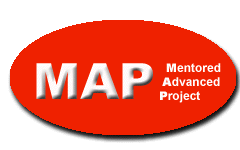
Summary
Results of MAP Assessment
Curriculum Committee
Grinnell College
April 9, 2002
1) Overwhelmingly, those who have directed and carried out MAPs describe the experience as academically valuable for students. (Sources: Student/Alumni surveys; Faculty MAP reports; discussions in Student Curriculum Council and academic divisions)
2) High levels of participation among students, high levels of faculty participation, and breadth of distribution across departments and divisions suggest widespread interest in having the MAP option in our regular curriculum. (Source: Dean's Office data on MAPs)
3) Some of the 400 projects carried out during the trial period would have taken place without a MAP program, while others were made possible by the inspiration and funding provided through the FFE initiative. (Sources: Student/Alumni surveys; Faculty MAP reports)
4) Students seem to derive similar benefits from activities that meet the MAP definition or that involve intensive student-faculty research, whether or not such projects are labeled "MAP." (Sources: David Lopatto's report, "MAPs versus NonMAPs"; Alumni survey)
5) As the primary benefit of carrying out a MAP or other "culminating academic experience," recent alumni reported having gained skills, experience, and confidence that directly supported their transition to graduate school, professional school, or a career. (Source: Alumni survey)
6) "Not having a chance," "didn't know about it," or "did not seem like an option" were the most frequent reasons given for not carrying out a MAP. (Sources: Student/alumni surveys)
7) Comments from students, faculty members, and alumni converge to indicate that this experience is not appropriate for all students. Some students lack the interest, motivation, focus, specific preparation, or general academic strength required to carry out a high-level independent project. (Sources: Student/Alumni surveys; Faculty MAP reports; divisional discussions)
8) Some faculty members who have directed MAPs say they intend to apply higher standards in the future when selecting MAP students (Sources: Faculty MAP reports; divisional discussions)
9) According to the faculty members who directed them, about two thirds of MAPs carried out during the trial period contributed directly to faculty scholarship. Analysis of faculty reports found a correlation between whether the project benefits faculty scholarship and how many hours the faculty member spends supervising the student. (Source: Faculty MAP reports)
10) Faculty members who directed MAPs requested the option to incorporate preparatory work and/or follow-up work as part of the project, allowing MAPs to extend beyond just one semester or summer. During the trial period, half the students continued to work with the MAP director on some aspect of their project after the official MAP ended. (Source: Faculty MAP reports)